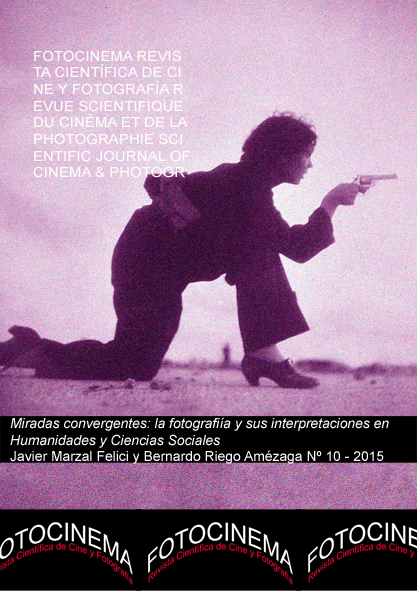La instantánea imposible: fotografía, neovanguardia y posmodernidad en el contexto del arte crítico contemporáneo
DOI:
https://doi.org/10.24310/Fotocinema.2015.v0i10.5983Abstract
Resumen:Las dificultades conceptuales que entraña la idea de posmodernidad en las prácticas fotográficas posteriores a 1970, no implican la inexistencia de un conjunto de actitudes icónicas que, vinculadas a la neovanguardia y a la consolidación de los estudios culturales y de género, mantienen un evidente diálogo con la tradición moderna. Más que plantear un repertorio de recetas visuales, la fotografía contemporánea, en tanto que momento inserto en la modernidad, articula una serie de discursos que, despojados de cualquier voluntad canónica, cuestionan el estatuto tradicional de la imagen y el sentido que lo posmoderno posee. El presente artículo busca contextualizar dichas posiciones en relación a dos parámetros. En primer lugar, y desde una perspectiva teórica, toma algunas de las reflexiones de Cartier-Bresson como paradigma de un pensar la fotografía que se contrapone a la voluntad político-ficcional y narrativa que se inicia con la crítica a la imposición lingüística tardo-moderna y a sus dictados formalistas. Por otro lado, el texto plantea la contextualización fotográfica en relación al desarrollo del arte contemporáneo y a su deriva antropológica, estableciendo una serie de características que toman como referencia visual el auge que en estas últimas décadas ha adquirido lo corporal como construcción cultural.
Abstract:
The conceptual difficulties with the idea of postmodernity in photographic practices after 1970 do not imply the non existence of a set of iconic attitudes which, linked to the neo-avantgarde and consolidation of cultural and gender studies, maintain an evident dialogue with modern tradition. Rather than propose a repertoire of visual recipes, contemporary photography, as a moment of modernity, articulates a series of discourses which, stripped of any canonical intention, question the traditional rules of image and meaning contained in the postmodern. This present article seeks to contextualise these positions in relation to two parameters. Firstly, and from a theoretical perspective, it takes Cartier-Bresson’s reflections as a paradigm for a philosophy of photography which runs counter to the political, fictional and narrative intention that begins with criticism of late modern linguistic imposition and its formalist dictates. Secondly, the text proposes photographic contextualisation in relation to the development of contemporary art and its anthropological drift, establishing a series of characteristics that take as visual reference the rise in recent decades of the body as a cultural construction.
Palabras clave:
Fotografía posmoderna; imagen; cuerpo; neovanguardia; estudios culturales.
Keywords:
Postmodern Photography; Image; Body; Neo-avantgarde; Cultural StudiesDownloads
Metrics
Publication Facts
Reviewer profiles N/A
Author statements
Indexed in
-
—
- Academic society
- N/A
- Publisher
- Universidad de Málaga
Downloads
Published
How to Cite
Issue
Section
License
All contents published in Fotocinema Revista científica de cine y fotografía are protected under the Creative Commons Attribution-NonCommercial-ShareAlike 4.0 International (CC BY-NC-SA 4.0) license. All about this license is available in the following link: <http://creativecommons.org/licenses/by-nc-sa/4.0>
Users can copy, use, redistribute, share and exhibit publicly as long as:
- The original source and authorship of the material are cited (Journal, Publisher and URL of the work).
- It is not used for comercial purposes.
- The existence of the license and its especifications are mentioned.
There are two sets of authors’ rights: moral and property rights. Moral rights are perpetual prerogatives, unrenounceable, not-transferable, unalienable, imprescriptible and inembargable. According to authors’ rights legislation, Fotocinema. Revista científica de cine y fotografía recognizes and respects authors moral rights, as well as the ownership of property rights, which will be transferred to University of Malaga in open access. The property rights are referred to the benefits that are gained by the use or the dissemination of works. Fotocinema. Revista científica de cine y fotografía is published in an open access form and it is exclusively licenced by any means for doing or authorising distribution, dissemination, reproduction, , adaptation, translation or arrangement of works.
Authors are responsable for obtaining the necessary permission to use copyrighted images.














13.png)



